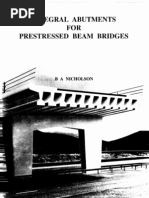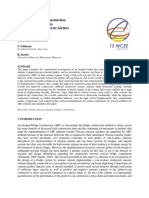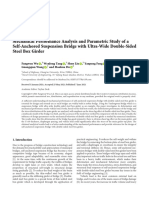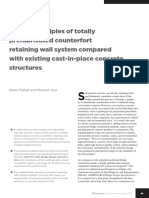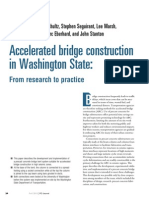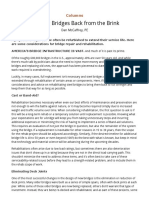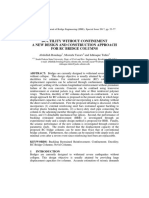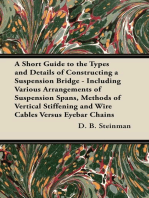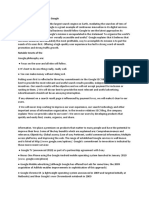2.4 Integral Bridge Design Approach
2.4 Integral Bridge Design Approach
Uploaded by
Lama20Copyright:
Available Formats
2.4 Integral Bridge Design Approach
2.4 Integral Bridge Design Approach
Uploaded by
Lama20Original Title
Copyright
Available Formats
Share this document
Did you find this document useful?
Is this content inappropriate?
Copyright:
Available Formats
2.4 Integral Bridge Design Approach
2.4 Integral Bridge Design Approach
Uploaded by
Lama20Copyright:
Available Formats
2.
4 Integral bridge design approach
Due to Auckland’s geographic location, and hence relatively low earthquake loads, bridges, where possible,
were designed with fully integral piers. As a result, the number of bearings was significantly reduced as beams
are supported on mortar pads. Fewer expansion joints were required because the columns and piles
contribute to the overall longitudinal stiffness of the structures which minimize the longitudinal movement
due to temperature and shrinkage. As can be seen, the integral piers will require less maintenance and provide
improved durability and whole-of-life costs to the client by reducing the direct cost as well as the costs
associated with traffic management during inspections and replacement activities during the operational
phase.
However, additional design steps were required, such as specifying the staging of the deck pour and providing
limitations on beam age at the time of pouring the continuity diaphragms at piers. This determined the
magnitude of the effects of secondary creep due to dead load and prestress while also impacting the
construction program. Therefore, it was agreed that the midportion of the deck would be constructed first and
then the continuity of superstructure would be made at the beam age of 90 days. This eliminated the need for
additional reinforced bars installed in the Super-Tee end blocks protruding into pier diaphragms. The analysis
showed that the extended flexible strands have enough capacity for positive restraint moment over integral
piers, which significantly facilitated the construction during the installation of precast beams.
The adoption of the fully-integral connection resulted in additional requirements such as soil-structure
interaction analysis, as well as the effective design under seismic load cases. Due to the latter, the balanced
stiffness approach was adopted in the form of the slots at the top of columns and the oversized steel sleeves at
the column interface with shaft piles, as shown in Figure 3c. As a result, the reinforcement ratios for the piers
are more uniform and optimised. Additionally, the overstrength effects of columns' plastic hinges on piles and
superstructure are reduced. The similar stiffness between the portions of the bridge structure separated by
expansion joints was provided to avoid the out of phase motion between them and hence hitting.
Besides the more advanced analysis required during the detailed design stage, the fully integral piers benefit
not only by the early mentioned reduction in the number of bearings and expansion joints but also by a better
capacity to sustain the live traffic. Also, the health and safety on site is essentially improved due to elimination
of risks associated with working at height during the casting end-beam diaphragms and maintenance and
replacement activities linked with bearings.
Figure 8 illustrates typical structural details for an integral pier connection with reinforcement needed for
sagging demands.
You might also like
- Encounters in Port NyanzaruDocument26 pagesEncounters in Port NyanzaruNessRage100% (8)
- Integral Abutments For Prestressed Beam BridgesDocument89 pagesIntegral Abutments For Prestressed Beam BridgesBridgy mcbridge100% (5)
- Reinforced Concrete Buildings: Behavior and DesignFrom EverandReinforced Concrete Buildings: Behavior and DesignRating: 5 out of 5 stars5/5 (1)
- Nataraja TempleDocument74 pagesNataraja TempleudayNo ratings yet
- Walt Disney Records The Legacy Collection: DisneylandDocument24 pagesWalt Disney Records The Legacy Collection: DisneylandНадежда Рыжкина100% (4)
- ppPYZTmyoTFKf09Mp2AsDbEZ8eeO0hG5FKMBxKvp PDFDocument98 pagesppPYZTmyoTFKf09Mp2AsDbEZ8eeO0hG5FKMBxKvp PDFSardar jiNo ratings yet
- Accelerated Bridge Construction in High Seismic Regions by Use of Precast Concrete GirdersDocument10 pagesAccelerated Bridge Construction in High Seismic Regions by Use of Precast Concrete GirdersxNo ratings yet
- 039 - Connal Austroads 04Document19 pages039 - Connal Austroads 04Lidija GrbicNo ratings yet
- Suitability of Bridge Made With Precast Components in Areas of High or Moderate SeismisityDocument14 pagesSuitability of Bridge Made With Precast Components in Areas of High or Moderate Seismisitypmullins_11No ratings yet
- AustRoads Integral AbutmentDocument19 pagesAustRoads Integral AbutmentMuhammad AbdullahNo ratings yet
- Assets - Htmlfiles - JCE 1749.HTML# - Text in The Prestressed Steel-Concrete Composite Bridge, The External Tendons, Ducts To House The TendonsDocument12 pagesAssets - Htmlfiles - JCE 1749.HTML# - Text in The Prestressed Steel-Concrete Composite Bridge, The External Tendons, Ducts To House The Tendons2021uce0050No ratings yet
- The Basohil Cable Stayed BridgeDocument7 pagesThe Basohil Cable Stayed BridgeNagar NitinNo ratings yet
- Spliced Girder BridgeDocument15 pagesSpliced Girder BridgePartha Pratim Roy100% (1)
- Student Paper S-3 ChengDocument14 pagesStudent Paper S-3 ChengRobert BishopNo ratings yet
- 2008 - Precast Post Tensioned Concrete Towers For High Power Wind Turbines Antonio MariDocument6 pages2008 - Precast Post Tensioned Concrete Towers For High Power Wind Turbines Antonio MariAmela ShahiniNo ratings yet
- (4-24)DESIGN_AND_CONSTRUCTION_OF_THE_KATSURASH_Naoki_HAGIWARAIMA_JapanDocument10 pages(4-24)DESIGN_AND_CONSTRUCTION_OF_THE_KATSURASH_Naoki_HAGIWARAIMA_JapanMOHAMED REDHA SOLTANINo ratings yet
- Ass FinalDocument10 pagesAss FinalTajura TamiraatiNo ratings yet
- Design of Aberdeen Channel Bridge - Hong KongDocument8 pagesDesign of Aberdeen Channel Bridge - Hong KongUlasi IfeanyiNo ratings yet
- Design and Construction Highway Piers With Interlocking Hoops in JapanDocument8 pagesDesign and Construction Highway Piers With Interlocking Hoops in JapanRamesh BabuNo ratings yet
- Digital Assignment 1Document4 pagesDigital Assignment 1Atul RajNo ratings yet
- Launching of Pre Stressed Girder by James R LibbyDocument19 pagesLaunching of Pre Stressed Girder by James R LibbyhammadhouseNo ratings yet
- Time-Dependent Behavior of Continuous Composite Integral Abutment BridgesDocument10 pagesTime-Dependent Behavior of Continuous Composite Integral Abutment BridgesMuhammad AbdullahNo ratings yet
- (Yen & Khaleghi, 2016) Design and Construction Challenges of Jointless Bridges in Seismic RegionsDocument23 pages(Yen & Khaleghi, 2016) Design and Construction Challenges of Jointless Bridges in Seismic RegionsAnderson UrreaNo ratings yet
- Challenging Construction and Erection Methods For The Izmit Bay Suspension Bridge and The 3rd Bosphorus BridgeDocument10 pagesChallenging Construction and Erection Methods For The Izmit Bay Suspension Bridge and The 3rd Bosphorus BridgeMassimo Averardi RipariNo ratings yet
- The Design of Precast Concrete Segmental Bridge PiersDocument10 pagesThe Design of Precast Concrete Segmental Bridge PiersMrAgidasNo ratings yet
- Pci Bridge Design Manual: Strategies For EconomyDocument0 pagesPci Bridge Design Manual: Strategies For EconomyjimmydomingojrNo ratings yet
- Self-Anchored Suspension Bridge With Ultra-Wide Box GirderDocument15 pagesSelf-Anchored Suspension Bridge With Ultra-Wide Box GirderCristian Camilo Londoño PiedrahítaNo ratings yet
- Design Principles of Totally Prefabricated Counterfort Retaining Wall System Compared With Existing Cast-In-Place Concrete StructuresDocument18 pagesDesign Principles of Totally Prefabricated Counterfort Retaining Wall System Compared With Existing Cast-In-Place Concrete StructuresHtin LynnNo ratings yet
- Accelerated Brideg Construction in Washington StateDocument16 pagesAccelerated Brideg Construction in Washington StatesyedabdulhannanNo ratings yet
- Steel and Concrete Composite Design For Long-Span BridgesDocument6 pagesSteel and Concrete Composite Design For Long-Span BridgesamigotNo ratings yet
- Bridge Girders-Strength at TransferDocument11 pagesBridge Girders-Strength at TransferAndy AcousticNo ratings yet
- Design and Construction of The Katsurashima ViaductDocument10 pagesDesign and Construction of The Katsurashima Viaductpmullins_11No ratings yet
- Comparative Study of Prestressed Steel - Concrete Composite Bridge of Different Span Length and Girder SpacingDocument6 pagesComparative Study of Prestressed Steel - Concrete Composite Bridge of Different Span Length and Girder SpacingPreeti AgarwalNo ratings yet
- 1-s2.0-S2352710221014947-mainDocument22 pages1-s2.0-S2352710221014947-mainSohini MishraNo ratings yet
- Common Fabrication ProblemsDocument10 pagesCommon Fabrication Problemsshivu khatriNo ratings yet
- Bringing Bridges Back From The Brink: ColumnsDocument10 pagesBringing Bridges Back From The Brink: Columnsalberto rosadoNo ratings yet
- Accelerated Short Span Bridge-PowellDocument6 pagesAccelerated Short Span Bridge-PowellNurali MamenNo ratings yet
- Haydar 2018Document13 pagesHaydar 2018fahmi aballiNo ratings yet
- Integral Bridges: What Is An Integral Bridge?Document20 pagesIntegral Bridges: What Is An Integral Bridge?Akhilesh Goje100% (1)
- Strengthening of The Cable-Stayed Bridge Over Danube at AgigeaDocument8 pagesStrengthening of The Cable-Stayed Bridge Over Danube at AgigeabulbucataNo ratings yet
- BS en 20898-7-1995Document10 pagesBS en 20898-7-1995Prapa KaranNo ratings yet
- Effect of High Strength Concrete Columns On The Behavior of Slab-Column ConnectionsDocument10 pagesEffect of High Strength Concrete Columns On The Behavior of Slab-Column ConnectionsIHAB SORORNo ratings yet
- BridgeDocument12 pagesBridgeIAhoeNo ratings yet
- Design and Analysis of Beam Supported BridgeDocument8 pagesDesign and Analysis of Beam Supported BridgeBhanu Prakash BNo ratings yet
- Suco 201800263 PDFDocument9 pagesSuco 201800263 PDFmocker1987No ratings yet
- Detail Design of Bridge Abutment 1Document4 pagesDetail Design of Bridge Abutment 1mohammad azim100% (1)
- Case Study: Widening An Existing Bridge Structure Challenges and SolutionsDocument8 pagesCase Study: Widening An Existing Bridge Structure Challenges and Solutionsmohammad hamdanNo ratings yet
- Article5AbutmentDesigninAASHTO LRFDDocument75 pagesArticle5AbutmentDesigninAASHTO LRFDsrijaNo ratings yet
- Mechanical Performance Analysis of Prestressed Con PDFDocument6 pagesMechanical Performance Analysis of Prestressed Con PDFTamir EnkhNo ratings yet
- 14 - Section 7.1 - Integral Abutments (E) PDFDocument38 pages14 - Section 7.1 - Integral Abutments (E) PDFDr. MOHAMED ALZAINNo ratings yet
- Paper - Integral BridgesDocument10 pagesPaper - Integral BridgesviralisursNo ratings yet
- IJBE-5-3-2017 Li 123 131Document10 pagesIJBE-5-3-2017 Li 123 131Shreedhar Ramachandrayya RNo ratings yet
- Shapes and Sizes of Web Opening Effects On Bending Behaviour of I-Beam With Web OpeningDocument9 pagesShapes and Sizes of Web Opening Effects On Bending Behaviour of I-Beam With Web OpeningKousalya MkNo ratings yet
- Modifed Approach Transverse Deck Slab DesignDocument8 pagesModifed Approach Transverse Deck Slab DesignhkhcsbNo ratings yet
- CaseStudy4-Sarhosis2024Document18 pagesCaseStudy4-Sarhosis2024msinanacikgozNo ratings yet
- Strengthening of The Cable-Stayed Bridge Over Danube at AgigeaDocument8 pagesStrengthening of The Cable-Stayed Bridge Over Danube at AgigeaIonutRacanelNo ratings yet
- 300m Span FRP Footbridges 2014Document9 pages300m Span FRP Footbridges 2014David KendallNo ratings yet
- Ijbe Special Issue 2017 Boudaqaetal 53 77Document26 pagesIjbe Special Issue 2017 Boudaqaetal 53 77jasimabdNo ratings yet
- Special Concretes: ST George Wharf Case StudyDocument4 pagesSpecial Concretes: ST George Wharf Case StudyAlf HorsemanNo ratings yet
- Long-Term Structural Performance of Modular High-Rise Concrete Building (CEB-FIB International Conference Oslo June 2022)Document10 pagesLong-Term Structural Performance of Modular High-Rise Concrete Building (CEB-FIB International Conference Oslo June 2022)Goh Kay YunNo ratings yet
- Slipforming of Advanced Concrete Structures: K.T. FossaDocument6 pagesSlipforming of Advanced Concrete Structures: K.T. FossaguruspclNo ratings yet
- Maurer Soehne BrueckenbauDocument4 pagesMaurer Soehne BrueckenbauVERUSH13No ratings yet
- A Short Guide to the Types and Details of Constructing a Suspension Bridge - Including Various Arrangements of Suspension Spans, Methods of Vertical Stiffening and Wire Cables Versus Eyebar ChainsFrom EverandA Short Guide to the Types and Details of Constructing a Suspension Bridge - Including Various Arrangements of Suspension Spans, Methods of Vertical Stiffening and Wire Cables Versus Eyebar ChainsNo ratings yet
- JM48367 Hook MiniscoreDocument16 pagesJM48367 Hook MiniscoreJulien ThoreNo ratings yet
- Project 1 1Document21 pagesProject 1 1Dev SharmaNo ratings yet
- 360DigiTMG PromoDocument2 pages360DigiTMG PromoSangeetha ChandrasekaranNo ratings yet
- Chapter 1 Down The Rabbit-HoleDocument11 pagesChapter 1 Down The Rabbit-HoleDiana ToncelNo ratings yet
- Handout On CocktailsDocument5 pagesHandout On CocktailsShubham SharmaNo ratings yet
- Juhi Resume UpdatedDocument3 pagesJuhi Resume Updatedcs.pooja26No ratings yet
- WMInstruct 18Document5 pagesWMInstruct 18Sahil GuptaNo ratings yet
- FS2 Learning Experience 3 ELLEDocument5 pagesFS2 Learning Experience 3 ELLEJhunnelle AlinsunurinNo ratings yet
- Tamir AntenehDocument149 pagesTamir AntenehAmeNo ratings yet
- Jodi DeanDocument19 pagesJodi DeanThilina DanushkaNo ratings yet
- CASE STUDY - GoogleDocument2 pagesCASE STUDY - GooglenileshNo ratings yet
- SOAL BAHASA INGGRIS KELAS 7 SMP - MTs - QuizizzDocument4 pagesSOAL BAHASA INGGRIS KELAS 7 SMP - MTs - QuizizzSmart Club BandungNo ratings yet
- Koch, E (2013) Death and Justice, in Current Issues and Enduring Questions, 10th Edition, S Barnet & D Bedau, EdsDocument5 pagesKoch, E (2013) Death and Justice, in Current Issues and Enduring Questions, 10th Edition, S Barnet & D Bedau, EdsJoey YanNo ratings yet
- Your Order Has Been Shipped!Document3 pagesYour Order Has Been Shipped!Saketh ReddyNo ratings yet
- Netwatch Installation For WindowsDocument12 pagesNetwatch Installation For WindowsleonardomarinNo ratings yet
- Eddie Smith Help Your Group Pray in One AccordDocument6 pagesEddie Smith Help Your Group Pray in One AccordGin BurdaNo ratings yet
- GarlicDocument11 pagesGarlicDanielCoronia100% (1)
- Charged UpDocument15 pagesCharged UpholeaNo ratings yet
- RC - 3.4 Yency HernandezDocument3 pagesRC - 3.4 Yency HernandezAdriana Agudelo HenaoNo ratings yet
- Adding Substitution Field - GGB1: Sanil K BhandariDocument3 pagesAdding Substitution Field - GGB1: Sanil K BhandariBibhuti MohantyNo ratings yet
- Council of JavnehDocument4 pagesCouncil of JavnehJon100% (1)
- CASE ToolsDocument20 pagesCASE ToolsJanhvi KagranaNo ratings yet
- Unit4 v1.0023106206Document26 pagesUnit4 v1.0023106206thanh vienNo ratings yet
- Crafts, Specialists, and Markets in Mycenaean Greece Exchanging The Mycenaean EconomyDocument9 pagesCrafts, Specialists, and Markets in Mycenaean Greece Exchanging The Mycenaean EconomyMuammer İreçNo ratings yet
- Gnav TheoryDocument9 pagesGnav TheoryMNo ratings yet
- G Mango Accounting Pack Model DataDocument13 pagesG Mango Accounting Pack Model DataalphabetttNo ratings yet

